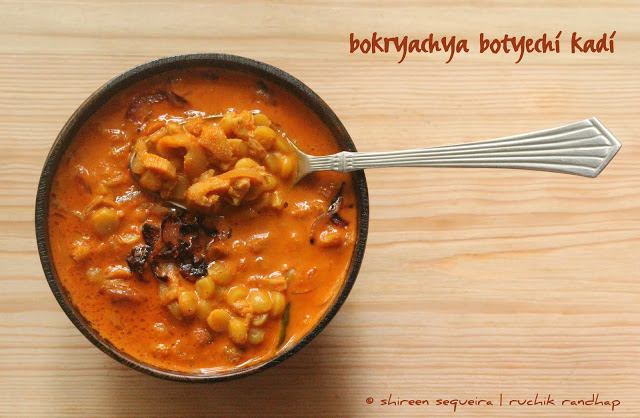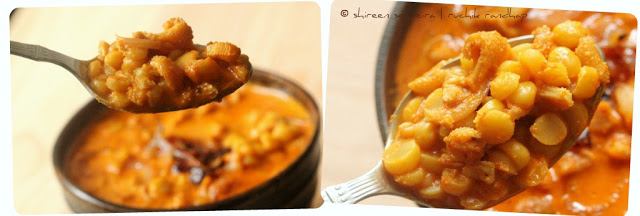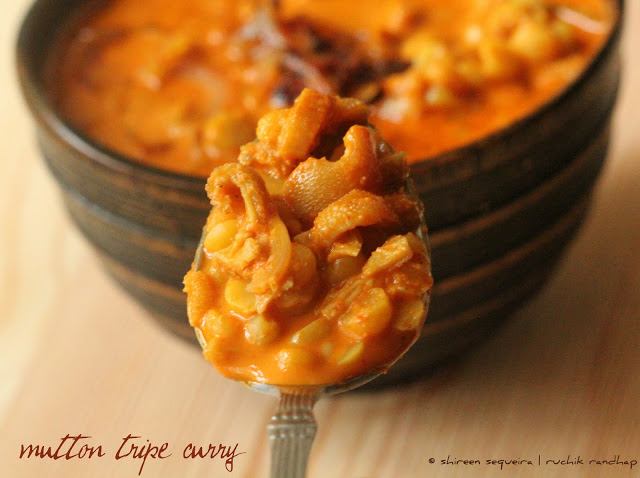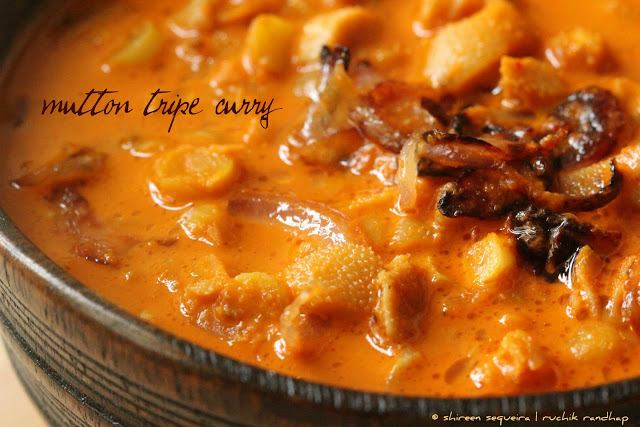Let me begin my post with a statutory warning! Vegetarians beware! And those of you who think eating anything apart from the flesh from the visible parts of a bird or animal is unthinkable or next to offensive, stop right here!
For those of you who think this is an exotic unheard of dish or the tasted-a-million-times and love it dish, let me tell you that I belong to both the categories. Bokryachi Boti (let us call it simply ‘boti) was an unheard of exotic dish (only for me although my family had eaten it) till I got married and after that I’ve had it a lot of times at my in-laws. The only reason why my mum-in-law still continues to slave over this Mangalorean delicacy is because R simply loves it. So each time we visit Mangalore, among the other specialities, the Boti curry finds its way on the ‘to-make while they’re here’ list. It must be noted that in Hindi, Boti simply means tiny pieces (usually of meat), however, in Mangalore, it is actually a collective term for Tripe.
Not too many people make it at home any more as simply put ‘Tripe’ is nothing but the intestines of the Sheep and includes the stomach and cleaning it is a big task that involves a huge chunk of time and loads of effort. So what may sound offensive to some is actually a delicacy amongst Mangalorean Catholics with a lot of die hard fans of the Boti. Traditionally the cleaning of the Tripe was done at the washing stone which usually has access to plenty of water. Plenty of ‘cleaning’ ingredients ranging from Chuna/Suno (Edible Lime powder), bay leaves, cinnamon, cloves and salt were used along with boiling hot water to wash the intestines sparkling clean and devoid of odour. Today, due to space constraints and lack of gardens/yards or washing stones, people find it difficult to clean it at home and in India, the cleaning done by the butcher is not up to the mark unless you are able to find it at supermarkets with some standards. I am assuming it is available in a ‘pristinely’ clean condition abroad.
Last week R & I were making a list of our favourite Mangalorean foods which are dying a slow death, we thought we must include the Boti and try it at home if we chance upon it at the Butchers. Just like in Mangalore where you need to book the Boti in advance, we managed to do the same here at the Andheri market which is to us what the Vodli market at State Bank (a place named after the head office of the Bank) is to Mangaloreans living in Mangalore. Since I had never tried my hand at cleaning the Boti, my man did the honours (did I tell you he’s a great cook himself?) and spent a good 1-1/2 hours cleaning the spare parts to a bright Ujjala white! His madame then spent the next 45-50 minutes grinding the masala, boiling the lentils and putting this amazing dish together! I must tell you that we both enjoyed our experience doing the work we had split between us and proclaimed to each other that – boti ki kasam, we would do this once again! Next time we’d bring more Botis and clean and freeze it for later (who wants to do the hard work over & over again?)
If you have never tasted it, let me describe it for you – it’s a little chewy but tastes awesome along with the chana dal and a spicy coconut-y creamy gravy. Perfect for a special Sunday afternoon!
Mutton Tripe Curry (Botyechi Kadi)
Serves: 4-6
You Need:
- 1 Tripe
- 125gm chana dal
- salt to tase
- ghee 2-3 tbsp
- 1 cup thin coconut milk
- 2 cups thick coconut milk
For the masala
- 3/4th cup grated coconut
- 8 long red chillies (Kumti/Bedgi) *see note
- 7-8 peppercorns
- 1 tbsp coriander seeds/dhania
- 1 tsp cumin/jeera
- 1/4 tsp turmeric/haldi
- 1/2 inch ginger
- 1 small ball of tamarind
For the shindaap (cuttings)
- 1 medium size onion
- 2 green chillies
- 1 small pod of garlic (around 8-10flakes)
For the tempering/seasoning
- 1/2 onion sliced fine
- ghee or oil
Method:
1. Clean the tripe with lots of freshly boiled water and remove (scrape) the outer skin with the help of a knife. Clean the insides thoroughly with plenty of salt, bay leaves, cinnamon & cloves. Wash multiple times in fresh cool water till all the odour vanishes. Pressure cook with bay leaves, cloves and cinnamon and the ingredients mentioned in ‘For the shindaap’ . Remove and allow to cool and cut into small pieces. Keep aside (discard the bay leaves, cloves & cinnamon)
2. Cook the chana dal in plenty of water till well cooked but not mushy (soft enough to bite)
3. Heat some ghee in a heavy bottomed pan and fry all the ingredients mentioned under ‘For the masala’ one by one (separately). When they have sufficiently cooled, grind to a fine paste using a little water.
4. Add this masala back to the pan and the masala water from the mixer jar to form a thick gravy. Add the tripe pieces, mix well. Add the thin coconut milk and the precooked chana dal and boil for 2 minutes (or lesser, depending on how much the dal has cooked -don’t allow it to turn mushy). Finally add the thick coconut milk and bring the gravy to a rolling boil, leaving the pan uncovered. Season it with 1/2 onion sliced fine and turn off the flame
5. Serve hot with steaming white or brown rice




Great looking curry. Excellent preparation.
Deepa
Hamaree Rasoi
Yummy dish… We prepare it in a slightly different way. Your version looks truly delicious:)
Reva
Even Bondas (squid) is prepared similarly. Not sure if the masala is the same but the combination is ! Awesome it is..
Oh Excellent! Been looking for this curry all over. I love your blog. thanks for posting this recipe
I tried it n it tasted really yumm!! Added shahjeera and garam masala to the masala. Omited the chana dal n coconut milk n made it ghassi. A must try recipe : )
@ Dale: Glad you enjoyed it! The shahjeera is not added traditionally but it does bring in a nice twist to the flavour I am sure 🙂
Shireen, for how long should we pressure cook the tripe? I plan to try out your recipe. Thanks
@ Lydia: It really depends on the tripe and how tender it is. I suggest you cook it for 15 mins and check. You can take 1 whistle and then reduce the heat to a sim and continue to cook it for another 5-8 mins (total time not exceeding 20 mins) – this is just a rough idea. I had forgotten to note down the cooking time when we had made this dish a few years ago
I love tripe au naturelle ,partly because cooking it the way my mum does is a huge task. Manglorean mothers have the uncanny habit of making even the toughest jobs look simple. I hope I get it already cleaned and just dump it in the pressure cooker with some salt and pepper and throw in a some onions, lime juice and parsley. Sort of a som Thai but with slivers of tripe instead of pappaya. Hope it tastes good:)
@ Des Lewis: I hope you enjoyed your version of tripe! And you bet! Mlorean mums know the knack of cleaning it well (dry cleaning I must say!)
Thank you
It turned out great
So glad to hear that Preethi!
Hi Shireen,
Tried this recipe on Saturday and it had come out delicious!! I was hoping to save some for Sunday evening, but unfortunately it got over quite quickly!! (With just me eating it!!) Yummy!! Thanks for the recipe!
Hi Sandy!
So glad you liked it 😀 Thanks for the feedback!
I tried your recipe twice and it came out delicious. I love your blog and thanks for the recipes.
Hi Jane,
Thank you so much for your appreciation! So glad that you liked this recipe! Thanks for your feedback!
Hi Shireen,
Tried this recipe today. It was yummy n perfect. I added 2 cloves, cinnamon stick and star anise for the masala. Pressure cooked the tripe with thin coconut milk rest as per your recipe for 5 whistles on slow fire n kept it to cool then opened the lid.
Hi Salma,
Thanks a lot for the lovely feedback and for sharing your tips! It will surely help someone! Thanks for taking the time to review the recipe